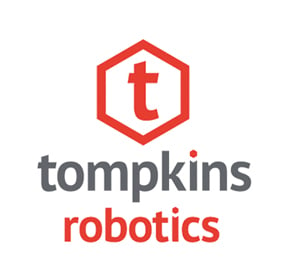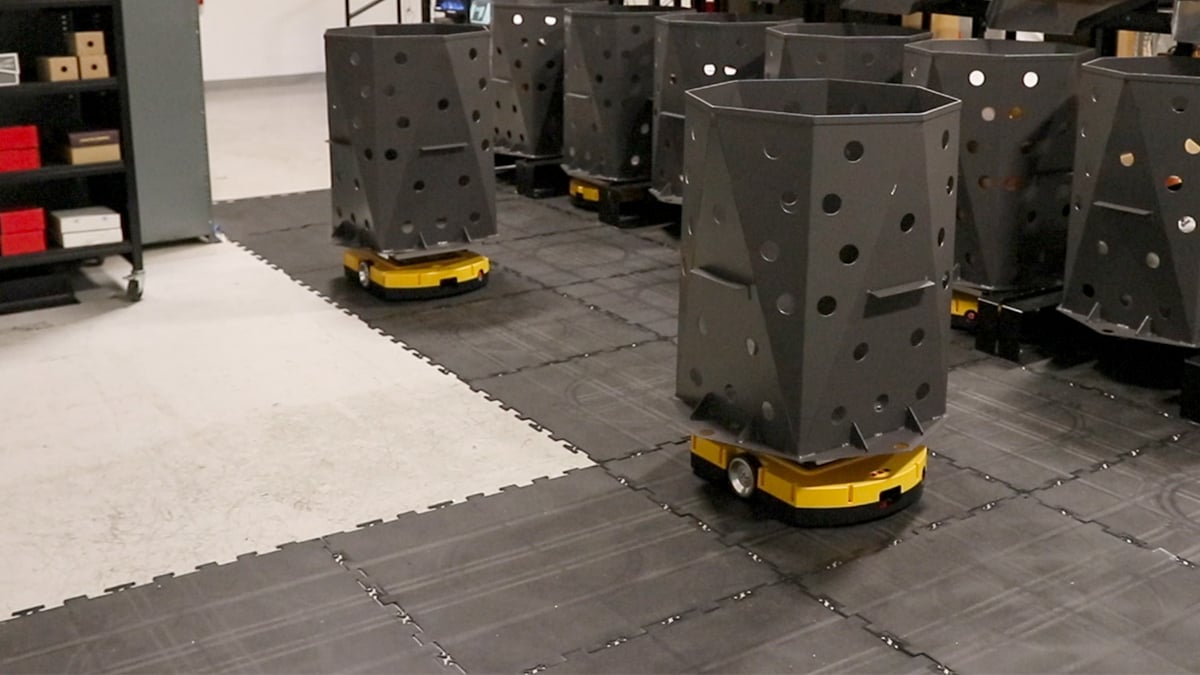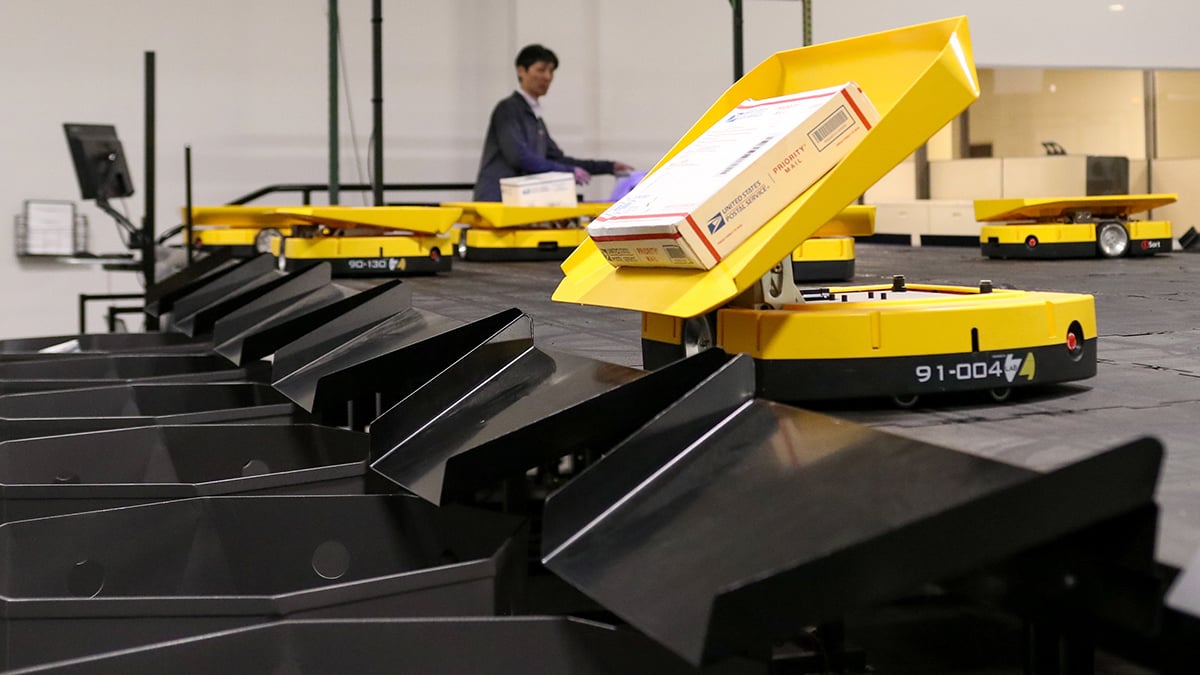You've invested millions in a high-speed sortation system. It can process thousands of parcels per hour across hundreds of destinations. But on your busiest days, you're running at 60% capacity. The problem isn't your sorter. It's what happens in the 30 to 100 feet after packages leave the chute.
Post-sort parcel handling is the hidden constraint in your operation. Your sorter runs fast, but manual movement from sort destinations to loading docks creates a bottleneck that limits throughput, burns labor hours, and breaks down during peak. For operations leaders running high-volume distribution centers with existing sortation infrastructure, solving this problem unlocks the capacity you already paid for.
Learn how solutions like xChange Parcel from Tompkins Robotics address this constraint by automating the manual handling steps between sortation exit points and final departure locations
The Post-Sort Bottleneck You Can't Sort Your Way Out Of
Automated sortation runs at 50 to 70% of rated capacity in most facilities. The reason is simple: downstream operations can't keep pace.
Your sorter can process 30,000 parcels per hour, but if your team can only move 18,000 parcels from chutes to docks in that same hour, the sorter waits. Chutes fill up. Staging areas congest. Parcels recirculate through the system. You lose 10 to 20% of your capacity to recirculation alone.
This isn't a sortation problem. It's a post-sort problem. The 50 feet between your sorter and your dock determines your real throughput.
Manual post-sort processes limit overall facility throughput by 40 to 60%. Large distribution centers employ hundreds of workers in post-sort roles at an annual cost of $9 million to $12 million. These workers swap full containers at chutes, transport sorted goods to staging areas, consolidate shipments by route, and load trucks. They spend more than half their time walking and moving materials.
During peak season, when demand spikes to 4 times normal levels, you need 4 times the labor. You can't hire fast enough. Throughput caps. SLAs slip. Network congestion cascades.
The constraint isn't technology. It's the manual handling steps you still rely on after sortation completes.
Why Manual Post-Sort Breaks Down
Manual post-sort operations create compounding problems:
Labor intensity caps throughput. Workers handle each parcel 2 to 5 times during post-sort. Walk time consumes 50% of their shift. As volume increases, accuracy drops. Error rates climb from 1.5% to 7% during peak periods.
Space constraints multiply costs. Staging areas consume 15 to 17% of your total facility footprint. In a 300,000 square foot facility, that's 50,000 square feet dedicated to accumulating sorted goods before they reach docks. At average industrial real estate costs, staging alone represents nearly $2 million in annual occupancy expense.
Dock congestion extends cycle times. Manual loading takes 15 to 30 minutes per truck. With limited dock doors, this creates queue delays that push shipments to the next delivery window. Late departures force expedited shipping to maintain service levels.
Peak demand creates structural failure. You can't staff 4 times normal headcount for seasonal spikes. The labor doesn't exist. Throughput drops 20 to 30% below theoretical maximum because you can't move parcels fast enough after they're sorted.
These problems compound. Staging congestion slows sortation. Slow sortation creates more staging congestion. Extended dock times cascade delays backward through the network.
Current Approaches and Their Tradeoffs
Most operations leaders address post-sort constraints with one of three approaches:
- Manual carts and tuggers offer low upfront cost but high recurring labor expense. They work for steady volumes but break under peak stress. Safety risks increase. Performance becomes unpredictable when you need reliability most.
- Conveyor extensions from sorters to docks deliver raw throughput but lock you into fixed paths. They consume floor space, cost hundreds of thousands to install, and take weeks to reconfigure. Permits and downtime add months to any layout change. They work when workflows stay consistent but fail when you need flexibility.
- Pallet jacks and forklifts move bulk loads but don't solve the problem in high-volume ecommerce distribution centers where you're handling individual parcels, not pallets. Even in facilities where palletization makes sense, these tools still require operators for every trip. Sequential one-load-at-a-time operations create bottlenecks. Licensed operators represent a limited talent pool. Accident rates remain high in congested sort areas.
Each approach addresses part of the problem but creates new constraints. Manual solutions can't scale. Conveyors lock you into fixed paths. Equipment still requires operators. What's missing is a layer that complements your existing sortation infrastructure without replacing it, locking you into fixed paths, or requiring facility modifications. That's where AMR solutions like xChange Parcel come in.
The AMR Warehouse Layer for Post-Sort Parcel Movement
Autonomous mobile robots built for post-sort parcel handling close the gap between sortation endpoints and loading docks. Unlike fixed conveyors, AMRs navigate dynamically. Unlike manual operations, they scale instantly.
xChange Parcel from Tompkins Robotics is specifically designed to solve the post-sort bottleneck. It's a floor-running AMR solution that works with any existing sortation system to eliminate manual parcel handling at exit points.
The robots operate on your existing floor, require no facility modifications, and deploy during normal business hours, and integrate with your current WMS and sortation control systems through standard APIs.
What sets xChange Parcel apart from other automation approaches:
Works with any sorting system. The solution is infrastructure-independent. Whether you run loop sorters, linear sorters, or any other configuration, xChange Parcel retrofits to your existing setup without modifications.
No single point of failure. Unlike conveyor systems that can shut down entire operations, xChange Parcel uses a distributed robot fleet. If one robot goes offline, the others continue operating. Your operation stays resilient.
Deploy without downtime. Installation happens during normal operations. No shutdown required. No facility modifications. No permits for fixed infrastructure. You're operational in days, not months.
Scale precisely with demand. Add robots during peak season. Reduce fleet size during slower periods. You scale capacity without the fixed costs of permanent infrastructure.
Here's how it changes your operation:
Higher sorter utilization. xChange Parcel automatically swaps full containers at chute endpoints and transports completed orders. Your sorter runs at rated capacity. No more waiting for workers to clear chutes. Recirculation drops. Capacity utilization improves 25 to 40%.
Fewer manual touches. Manual handling labor at sortation exit points drops up to 80%. Workers stop spending 50% of their time walking and transporting. They focus on exceptions, quality checks, and higher-value tasks.
Peak resilience. Adding robots takes minutes, not weeks of hiring and training. When demand spikes to 4 times normal volume, you scale capacity without multiplying headcount. SLAs hold. Overtime costs disappear.
Faster dock turns. Automated replenishment of empty containers and immediate transport of completed orders keeps dock doors moving. Truck dwell time drops. Staging congestion clears. Your dock capacity increases without adding doors.
Consistent performance. Labor shortages don't impact operations. Performance stays consistent 24/7 regardless of staffing levels. Training requirements for repetitive tasks disappear.
The system retrofits to your existing operation. You're not replacing sortation equipment or overhauling WMS. You're adding a flexible automation layer that maximizes your existing sortation investment.
Implementation and Results
Typical payback ranges from 6 to 18 months, with many xChange Parcel deployments showing ROI within 90 days. The calculation is straightforward: compare annual post-sort labor cost against automation investment. For a facility spending $10 million on 400 post-sort workers, reducing manual handling labor by 80% at sortation exit points delivers $8 million in annual savings. Capital cost for xChange Parcel deployment runs substantially lower than conveyor installations and scales incrementally.
Deployment happens in days for initial zones. Installation occurs during normal business hours without operational shutdown. You start with a pilot area, validate performance across different parcel types and throughput scenarios, then expand. No facility modifications required. No permits for fixed infrastructure.
Integration connects xChange Parcel to your warehouse execution system and sortation control software. The robots communicate with your existing systems through standard APIs. Fleet management software coordinates multiple robots in real time, optimizing routes and managing traffic. The distributed architecture maintains 99%+ uptime because individual robot issues don't impact overall operations.
Operations teams see immediate impact. Sorters run at higher utilization. Manual handling labor at exit points drops up to 80%. Dock doors turn faster. Staging congestion drops. Peak season doesn't require 4 times normal headcount or overtime costs. Workers focus on tasks that add value rather than repetitive material movement.
The Choice is Yours
You've invested millions in sortation infrastructure. The question now is whether you'll continue absorbing the cost and inefficiency of manual post-sort handling, or whether you'll deploy AMRs that work alongside your team to automate the step most operations overlook.
The bottleneck between your sorter and your dock determines your real capacity. You can staff your way through it with hundreds of workers and hope labor markets cooperate. Or you can automate it with a flexible AMR layer that scales with your operation and maximizes the sortation investment you've already made.
Request to See xChange Parcel in Action
Ready to unlock the throughput capacity you've already invested in? See how xChange Parcel closes the post-sort gap in high-volume distribution operations.
About Tompkins Robotics
Tompkins Robotics is a leader in warehouse robotic automation, specializing in sortation solutions that provide the optimal mix of flexible, simple, and powerful performance for your unique operational needs.
 Tompkins Robotics
Tompkins Robotics


